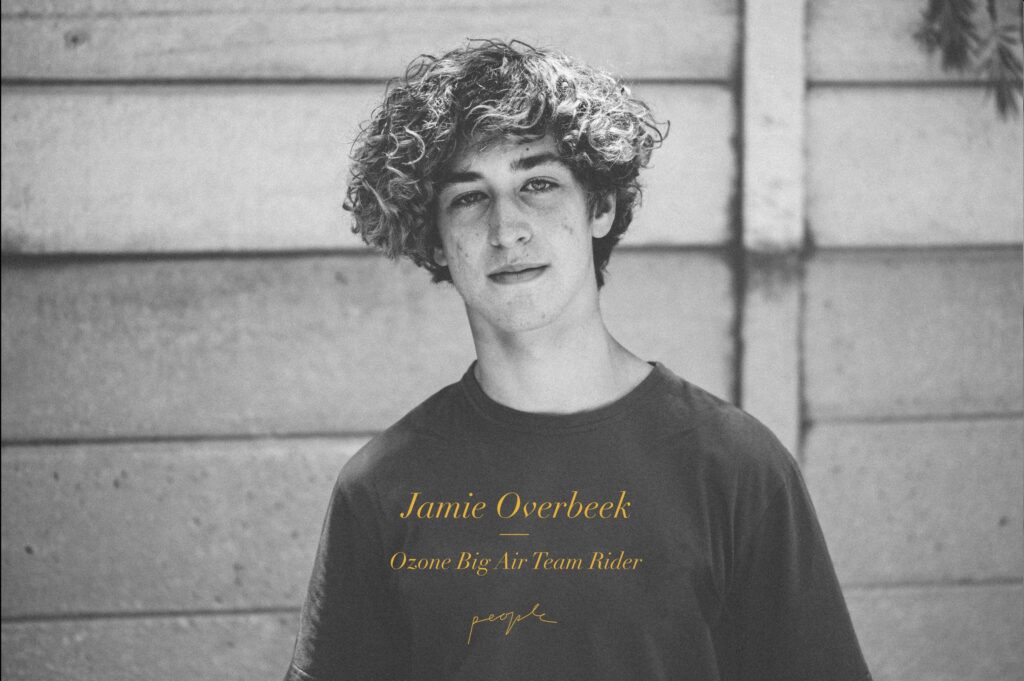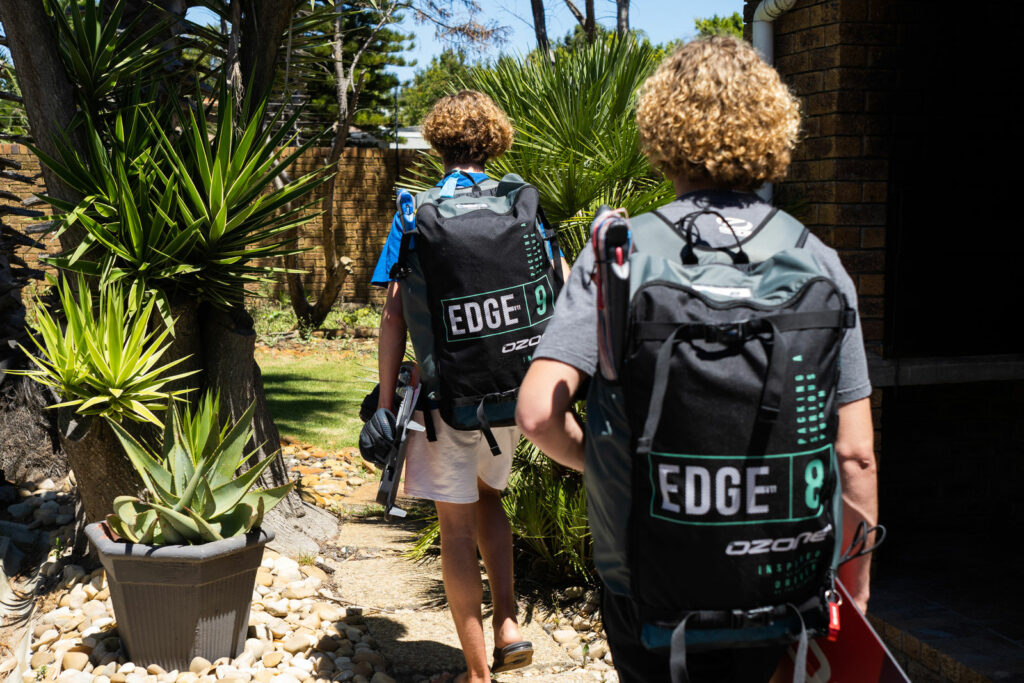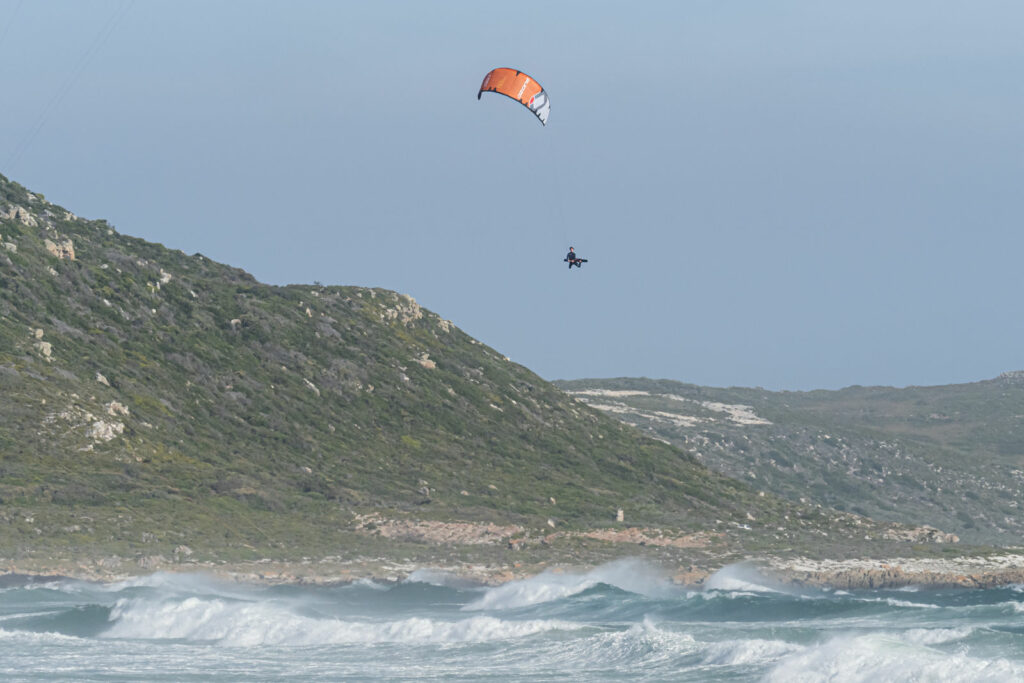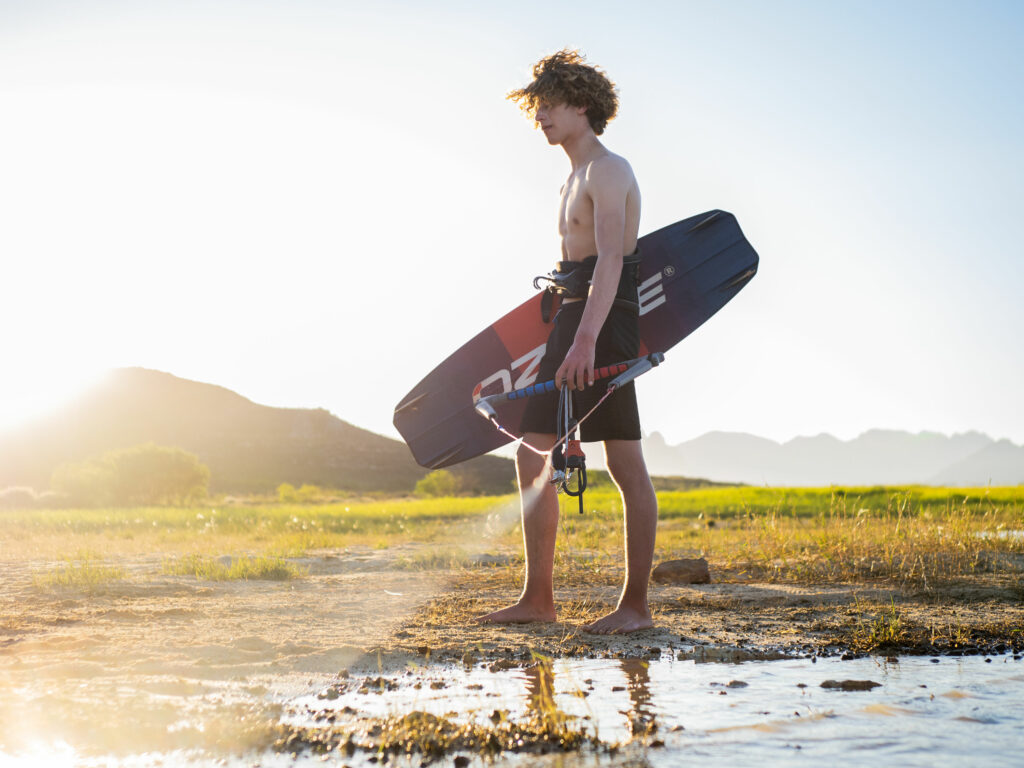
Ozone’s Big Air team rider, Dutchman Jamie Overbeek, just captured the European Woo record with an astonishing jump of 34.6 meters. The 16-year-old hit new heights on his 7m Ozone Edge V11 during Storm Eunice, when winds gusted to a mind-bending 60kts at his home spot of Workum, Netherlands. During a shooting trip to kiteboarding Mecca, Cape Town, South Africa, the teenager sat down with Ozone’s Marketing Manager David Tonijuan. They discussed his unusual kite of choice when not boosting on his beloved Edge V11s—Ozone Chrono V4, R1 V4 foil kites—and talked through his dreams and ambitions for what is bound to be a starry future.
David Tonijuan: Jamie, how did you start kiting?
Jamie Overbeek: My dad was flying small kites in Denmark. He gave me that kite. I flew it a few times and I liked it, so I started flying bigger kites and liked it too. So I did a kitesurfing course and I immediately was surfing away on the water. That all started my career in kiteboarding.
DT: How old were you when you started?
JO: I was nine years old when I started kiteboarding, and I had already [been] flying kites for about three years.

DT: We have seen you going to spots or riding always with your brother [Sean]. How is that for you? How does it feel for you when you’re together? Is it very important for you in your life?
JO: Yes, it’s very important. Because when I ride together with my brother I can push myself when I’m doing tricks. When Sean pulls a big trick I always have to do it too, or go even bigger, or certainly try it. When he’s not riding with me, I don’t feel the pressure on the water.

DT: What tricks are you working on now? What’s the best trick you can do, and what tricks would you like to do in the next year?
JO: My best trick? I don’t know. A Boogie Boardoff, a Kiteloop Late Boardoff. Something like that. My goal is to land a Doobie Boardoff Late Frontroll, clean.
DT: We’ve seen a lot of riders coming up strongly now throwing very technical tricks. What is the hardest trick people are doing right now?
JO: That’s a hard question. I think the Doobie Boardoff with a Late Front. I think that’s the hardest trick right now.

DT: We have seen you perform very well in the best competitions, like the Cold Hawaii Games. How were the conditions there and how did you perform at the event?
JO: It was nuking. In my first round I had a heat against Lasse [Walker], but the wind completely dropped and I was on my 7m [Ozone Edge]. I could have switched to my 8m, but I didn’t want to because I hadn’t flown it in a long time. So I stuck with the 7m, and it wasn’t enough. I lost that round. Then, in the next round I performed really, really well. Everything went as planned. I won that round and went to the next where I came up against Liam [Whaley]. That was a really hard round. But I performed like crazy. I’d never ridden as well as that. I was really happy. I lost by a little more than one point. That was a good experience.
DT: What are you looking at in 2022? Are you looking at doing all the events? Which are the events you will focus on?
JO: Definitely, if I get selected, [Red Bull] KOTA. I would like to ride in the [Red Bull] Megaloop Challenge. Definitely the Cold Hawaii Games, and some GKA Big Air events that are coming this year.
DT: We’ve seen you also flying a lot of foil kites. That’s strange, because we don’t see the main Big Air riders flying foil kites. But you’re pushing it to the next level. Why is that? What are you trying to achieve with those kites?
JO: It’s just that the other guys need a lot of wind on their tube kites to do some big stuff. But [with foil kites] I can go big in under 20kts. I can go 20-plus meters [high] with a boardoff and lots of hangtime. I think it’s really good to combine [the foil kites] with the tube kites because you have way more potential to try new tricks in low wind.
DT: That’s interesting. Tell us the main difference in the behaviour of the kites? When you jump with a foil kite, can you explain the main difference? Do you prefer one or the other?
JO: I prefer foil kites in light conditions, up to 25kts or so, because they perform way better than tube kites [in those conditions]. You have way more hangtime. You can go bigger and overall have way more fun in light conditions. Over 25kts you can already go massive on your tube kites, pull some big megaloops with late backrolls and stuff. So in light conditions foil kites are just way more fun.

DT: Do the foil kites jump in a different way to inflatable kites? We’ve seen that foil kites give a more floaty jump. You stay longer in the air. You have more hangtime. The inflatable kites have an extra boost at the beginning.
JO: The foil kite is less aggressive. They go up way slower, but you stay way longer in the air than with a tube kite. When you take off with a tube kite, it’s super-aggressive, but then you come down really quickly, you do a few kiteloops and you’ve already landed. But you have almost twice as much hangtime with a foil kite. Especially for things like board flips, you have more time to try new tricks without the worry.
DT: It’s great for people to understand the differences between the two and why they could get a foil kite for their riding. Do you also ride hydrofoils and jump high? We’ve seen you throwing big, big jumps and riding with a hydrofoil. What are the conditions that you go out with a hydrofoil?
JO: Hydrofoiling is just the key to low wind. When no-one else is riding in Holland, I’m out there on my hydrofoil pulling some loops. You don’t need that much wind to really train. Like with 3kts, my kite is flying, I get out and you can jump 13m when no-one else’s kite flies. That’s just amazing, to get a kite session when no-one else can.

DT: What about school? You’re 16 years old, but you’re pushing the level of kiteboarding at Pro level. That means you have to be kiting a lot of hours and that could interfere with school. What are your plans for next year?
JO: When it’s windy, I don’t go to school. I just go for a session and the school knows about all the kiting stuff, and it’s OK. When it’s really windy I can go [kiting], but I still have to do tests I missed. But it’s worth it and, yeah, it’s better to go for a kite session than go to school and [later] see all the big videos [of what you] missed. You don’t want that.
DT: What do you do with your free time, when you’re not kiting?
JO: When the weather’s nice, I go longboarding outside, or something. When it’s not nice I’m always doing a workout in the evening, and then some gaming with my friends in my room. We play a lot of shooter games.
DT: You guys live far from the beach. How far do you live from the beach and how do you make it happen?
JO: We always have to drive two hours to the beach when we want to kite. But my father always drives me to the beach because he also likes kiteboarding. But it’s tough sometimes, if the wind’s light and then it picks up, and you’re two hours from the beach and can’t do anything. That’s a bit shitty, but we can manage.
DT: Do you have a dream location? Is there a place you would like to go, or a place you’ve already been? Somewhere to increase your level and do better tricks?
JO: I really like my home spot in the Netherlands. It’s called Workum. You have a sandbar in front of that and it’s really, really flat [water], but the wind’s really gusty. But my overall favourite spot is here in Cape Town, Bloubergstrand. The wave is just amazing. You always see clips of guys doing some big stuff [here]. So you also want to push it over here.
DT: Is there anything else you’d like to say about the sport?
JO: Just try out this sport and you’ll like it. You’ll love it. It’s amazing!













